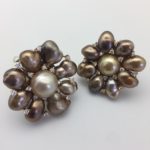The pearl that changed everything
Happy Birthday to the cultured pearl! On this day in Japan in 1893, Mikimoto founder Kokichi Mikimoto succeeded in creating the world’s first cultured pearl from a Japanese Akoya oyster, transforming this rare royal jewel, once only collected from the wild, into the sustainable, renewable gem we cherish today. Without Mikimoto, pearl oysters would likely have gone extinct due to depletion and the world would have lost one of its most exquisite treasures. Today, almost all pearls are born from within oysters that are nurtured and lovingly cared for by human hands. These cultured, husbanded pearls are very real indeed. Today’s salt water Akoya, Tahitian, South Sea, and Sea of Cortez pearls are all cultured, as are the Asian freshwater pearls. Only the beautiful pearls from the Arabian Gulf are still harvested from the wild and their harvesting is tightly controlled.
It’s a little confusing because most people want to know if their pearls are “natural”, or they may inadvertently refer to them as such (as opposed to faux pearl costume jewellery). The answer is, “yes and no”. To be correct, the term “natural pearl” is only to be associated with pearls collected from the wild. Today, in almost all places on earth this wild collection of pearls no longer happens in any commercial sense. Environmental factors have led to strict policies developed by producers and governments to ensure the protection of the clean waters required for pearl oysters to survive and to protect and enhance remaining populations of wild pearl oysters and their ecosystems. Today, if you see pearls labeled as “natural”, they either come from Bahrain or, more likely, are very old, acquired prior to wild harvesting protections, and if in great shape or of significant size, quite valuable. Any other pearls derived from pearl culturing labeled as “natural” are not being correctly represented. The good news is that the best cultured pearls have super-high quality surface characteristics (lustre, nacre thickness, natural color and surface finish) because they are pampered. In my mind, this makes them the perfect sustainable gem. We have everything to thank Kokichi Mikimoto for the beautiful, environmentally friendly, sustainable pearls available today.
featured image: A serene sunset overlooking the Mikimoto pearl farms at Toba on Japan’s Shima peninsula
image source: Mikimoto


